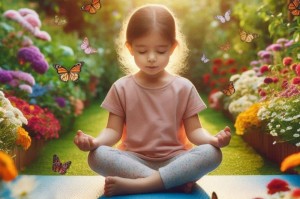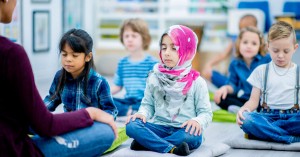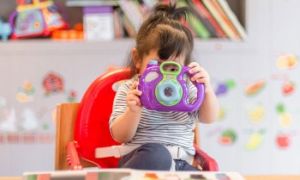Children, even young ones, regularly experience stress as they negotiate unfamiliar settings and people besides the turbulence of their own inner lives. The following article provides information on Using Calming Strategies for children, Teaching Self Regulation and more.
Be Prepared For Common Stressors
One of the simplest ways to help stressed children is to be prepared for common triggers. Being left by parents at a service or having another child take away a favourite toy are some of the usual stressors in young children. Different children may present stress-related symptoms differently, from feeling pukish and tummies that hurt to refusal to participate in an activity or disruptive behaviours.
Then there are individual situations for example a child acting out may have not slept well the previous night because of a younger sibling or just have a stuffy nose. Identifying the stressors and their causes can help you anticipate trouble and take steps to dial down the emotional arousal – like encouraging a nap or allowing unstructured play – so that they can feel calmer.
Use Calming Strategies
Among the ways, stressed children can be made to feel better are:
- Practising deep breathing. Taking long belly breaths slows the breathing process, in turn lowering the heart rate and relaxing muscles in the neck, head, shoulders and limbs. As the tension from muscles ebbs, the child feels calmer.
- Removing the child from the stress-inducing context and asking them to go out for a quick jog around the playground or lend the gardener a hand in watering the plants. A purposeful activity can take the kid’s mind off worry just as a bout of physical exertion can help one unwind.
- Alternating low and high-energy activities so that your learners get opportunities to release their physical energy as well as focus their minds.
- Encouraging the child to take a ‘time-out’ by crawling under a tent or relaxing on a bean bag; ensure that there are calm spaces in the classroom with plenty of soft surfaces.
- Participating in activities that require pulling, pushing or carrying heavy weights like wheelbarrow walking or sitting with a heavy backpack; such activities are particularly helpful when overstimulated leaners need to be calmed down.
- Using different sensory materials like tactile bins of beans or rice or jars of wet paint; some worriers are able to relax as they dig their hands and fingers into tactile bins or squelch colours and even mud.
Teach Self-Regulation Skills
Try and make coping skills part of everyday learning schedules. A good practice is to start the school day with a mindfulness or deep breathing exercise. Repeated low humming or slow, deliberate chants also tend to soothe the senses. Teach children to regulate their emotions, analyse situations and solve problems. Finally have open, age-appropriate conversations around mental health and designate safe spaces so that kids know that stress is part of life and it is alright to feel occasionally worried as long as they know when to ask for help.
Further Reading
Benefits Of Yoga For Children - The following article provides information on What Is Yoga, Benefits Of Yoga For Children, Teaching Children Yoga and more.
Calm Down Box For Children - The following article provides a list of self-regulates that can be included inside a calm down box.
Strategies To Comfort A Crying Toddler - The following article provides strategies you can use to comfort and soothe a toddler.
10 Strategies To Handle An Angry Child - The following article provides 10 strategies to handle an angry child.
Reset Activities For Children After A Tantrum Or Meltdown - The following article provides information on Reset Activities When To Use Rest Activities, Choosing Reset Activities and more.
Pattern Posters - Pattern Posters can be used as a calming down technique for children when they are feeling overwhelmed. Children can trace the pattern with their fingers or use stones to place along the pattern to help them focus when they are unsettled. These can also be used with playdough as well. These are a great addition to add to a Calming Corner.
Anger Management Posters - Anger Management Posters are great to display in a calm-down area to show children how to regulate their emotions when feeling overwhelmed or angry. Children can choose a task to do from the poster and when completing the task it will help them to calm down. These posters can also be added to a display folder that children can flip through and complete when they need some time to themselves.







 As an Educator in Australia, your pay rate falls under the Children’s Services Award 2010. This award states the minimum amount that an employer can
As an Educator in Australia, your pay rate falls under the Children’s Services Award 2010. This award states the minimum amount that an employer can When working as a qualified Early Childhood Teacher (with a university degree) within a service, your rate of pay will come from the Educational Services
When working as a qualified Early Childhood Teacher (with a university degree) within a service, your rate of pay will come from the Educational Services When working as a Diploma Qualified Educator your pay rate is from the Children's Services Award 2010. This Award states your minimum rate of pay
When working as a Diploma Qualified Educator your pay rate is from the Children's Services Award 2010. This Award states your minimum rate of pay When working as a Cert 3 Qualified Educator, your pay rate is from the Children's Services Award 2010. This Award states your minimum rate of
When working as a Cert 3 Qualified Educator, your pay rate is from the Children's Services Award 2010. This Award states your minimum rate of Educational Leaders play a crucial role in their early childhood service by ensuring that the educational program aligns with best practices and supports the holistic
Educational Leaders play a crucial role in their early childhood service by ensuring that the educational program aligns with best practices and supports the holistic In early childhood education and care, ratios are more than a technicality—they are a frontline safeguard. Every child deserves responsive supervision, emotional connection, and developmental
In early childhood education and care, ratios are more than a technicality—they are a frontline safeguard. Every child deserves responsive supervision, emotional connection, and developmental With the new national child safety reforms kicking in on 1 September 2025, early childhood services like yours have a real opportunity to lead the
With the new national child safety reforms kicking in on 1 September 2025, early childhood services like yours have a real opportunity to lead the Here’s a comprehensive Mobile Phone and Smart Watch Policy tailored for early childhood education and care (ECEC) services in Australia, aligned with the latest 2025
Here’s a comprehensive Mobile Phone and Smart Watch Policy tailored for early childhood education and care (ECEC) services in Australia, aligned with the latest 2025 The Sea of Fish Challenge is a national initiative that invites children, educators, families, and communities to create and display fish artworks as a symbol
The Sea of Fish Challenge is a national initiative that invites children, educators, families, and communities to create and display fish artworks as a symbol Across the early childhood education and care sector, educators are sounding the alarm: current staffing ratios are insufficient to deliver safe, meaningful, and developmentally appropriate
Across the early childhood education and care sector, educators are sounding the alarm: current staffing ratios are insufficient to deliver safe, meaningful, and developmentally appropriate


